|
The .32 S&W Long is regarded by some as an archaic artifact of another
time, best left to the dust of the Ages. I would suggest a less hasty
conclusion. Yes, it was originally introduced by Smith & Wesson in 1878. Yes, it
was originally housed in the weak Model 1 1/2 top-break revolver. Yes, it was
originally a black powder load only generating 680 fps with an 85 grain lead
round nosed bullet. Yes, it was introduced as a pocket pistol for self-defense,
and yes it was marginal in that application. Yes, smokeless powder, stronger
steels and the Magnum Age would come along and make such pip-squeak ballistics
"yesterday's news". So what? Is there a problem with all that?
While the hinged-frame top-break revolvers are indeed very weak and need
to be treated with care (i.e. loaded to black powder pressures only),
S&W entered the modern era with their first Hand Ejector (the Model 1896), and
it was chambered for the .32 S&W Long. The fixed frame of the Hand Ejector
series of revolvers would revolutionize the handgun world, and ultimately lead
to the first Magnums. With the introduction of smokeless powder, factory
ballistics for the .32 S&W Long were upped only slightly to a 98 grain lead
bullet at 705 fps (undoubtedly out of deference for the weaker top-break
revolvers). I have shot small game and vermin with lead round-nosed bullets at
roughly 700 fps -- head shots are effective, body shots leave a great deal to be
desired. The bottom-line is that these slow round-nosed bullets are just not a
humane hunting combination.
However, the fixed-frame Hand Ejectors were stronger than the older
top-break revolvers, and could be safely loaded to somewhat higher pressures
(i.e. 15,000 CUP). This increased pressure allows 90-100 grain cast bullets to
be pushed 900-1000 fps safely (for example, see the pressure-tested load data in
Phil Sharpe's "Complete Guide to Handloading"). Coupling this added velocity
with improved bullet designs bearing a decent meplat, and you now have an
excellent hunting combination for small game.
If this sermon sounds familiar, others have preached it long before me.
In "Sixguns" Elmer Keith summarized the .32 S&W Long as, "...a wonderfully
accurate target cartridge...but in factory loadings is a very poor game
cartridge." He went on to say, "Properly handloaded with a bullet like the Ideal
313445 and 4.0 grains of Unique for a velocity of 1000 fps, it is a wonderful
small game cartridge.". In "Hoglegs, Hipshots and Jalapenos" Skeeter Skelton
also sang the praises of the .32 S&W Long as being very accurate, although
underpowered for anything but the smallest game, and that its performance as a
hunting cartridge could be significantly enhanced by handloading. The load he
cited was comprised of a 95 grain cast bullet over 4.3 grains of Unique for 1010
fps. Generally speaking, when Skeeter was looking for this level of .32 caliber
ballistics, he usually turned to the .32-20 cartridge, but I suspect that was in
large part due to the fact that the .32-20 was available in his beloved Colt
Single Action Army, while the .32 S&W Long was not.
Several other gun writers have gone on record in favor of the .32
rimfire rifle as a preferred small game load. For those of you that might not be
familiar with the ballistics of the old black powder .32 rimfire loads, they
generally had an 80-90 grain lead bullet at 950-1050 fps. The .32 rim fires had a
reputation for adequate accuracy out to about 50 yards (black powder fouling
could be problematic), and would kill small game cleanly without spoiling a lot
of meat. When .32 rimfire ammo became scarce and hard to find, many of these
shooters moved on to reproduce these ballistics in a .32-20 rifle or revolver,
but the extra case capacity isn't necessary to achieve this ballistic level and
a solid-framed .32 S&W Long revolver is just as capable of reproducing the old
.32 rimfire ballistics (and accurate loads will probably be easier to find than
with the .32-20). This, I would argue, is the special niche that the .32 S&W
Long now occupies -- the ~95 grain bullet at 900-1000 fps, useful for hunting
small game.
Yes, we now have stronger steels and modern CNC machine capabilities,
and we can build better, stronger, more powerful revolvers than ever before.
Yes, we now have the .32 H&R Magnum and the .327 Federal, both capable of
delivering significantly higher velocities than the ancient .32 S&W Long. So
what? For the small-game hunter the bottom-line is that a rabbit is still a
rabbit, and a squirrel is still a squirrel. I really like Brunswick stew, and
I'm not a big fan of a whole lot of bloodshot goo. The .32 S&W Long kills small
game cleanly (it is significantly more effective that the .22 Long Rifle), and
doesn't spoil a lot of meat in the process. The .32 H&R Magnum and .327 Federal
are both fine varmint cartridges, but their extra velocity equates to a certain
amount of wasted meat when the quarry is intended for the dinner table. I have
(and hunt with) more powerful handguns, but when edible small game is on the
menu there is a strong probability that a .32 S&W Long revolver will be along
for the ride. Simply stated, when properly loaded, the .32 S&W Long is the
perfect small game cartridge.
Handloading the .32 S&W Long
The .32 S&W Long is pretty much a definitive "small case" in terms of
powder capacity. Uniform ignition is not a problem since the brisance of pretty
much any primer will completely fill the available volume in the loaded
round. The small case capacity, combined with the pressure limitations, make the
.32 S&W Long best served by the medium to fast burning pistol powders, ranging
from Bullseye on the fast side out to about HS-6 on the slow side. I have gotten
excellent results with Red Dot and W231 in the .32 S&W Long. Red Dot in
particular, bulks up well in the tiny case and has given me excellent accuracy
over the years in the .32 S&W Long. Bullseye, PB and American Select are also
excellent choices for the .32 S&W Long. A pound of powder goes a LONG ways when
it's metered out in 2.0 to 2.5 grain doses!
One of the things that appeals to me about the .32 S&W Long is how well
it performs with cast bullets. In fact, in all of the thousands and thousands of
rounds of .32 S&W Long that I've shot over the years, fewer than 1% of them have
involved jacketed bullets. At ~900 fps and 15,000 CUP, cast bullets are right at
home, and just make sense. With a gang mould and a pot full of lead, you can
make bunch of .32 cast bullets in a hurry from a few pounds of scrap
wheel weights! As far as mould designs go, there are some excellent .32
wadcutter moulds available from RCBS, NEI (I like #79 in PB form) and H&G
(originally listed as #66 by H&G, now available from Ballisti-Cast), and at one
time Lyman made a couple of very interesting variations on the .32 wadcutter
theme that make for very interesting field loads (the 95 grain 313445 SWC and
the 93 grain 313492 Type III wadcutter). Other .32 cast bullet designs worthy of
note are the timeless Lyman/Ideal 3118 (now labeled the 311008), the RCBS 98
grain SWC, the RCBS 88 grain Cowboy bullet, and SAECO also makes some good-lookin'
.32 moulds (I have an old Cramer 95 grain SWC that I am very fond of, a design
that SAECO still offers). Several years ago, I had Mountain Molds make a mould
for me to produce a 98 grain .312" Keith-style SWC (73% meplat, three equal
driving bands, beveled crimp groove and a big flat grease groove). A couple of
years later, this bullet was used as inspiration for one the Lee custom mould
Group Buys for a 6-cavity gang mould to make a .315" diameter 98 grain
Keith-style SWC (there were some changes made to the ogive and driving bands).
The bottom-line is that there is no shortage of good bullet moulds available to
the handgun hunter who wants to hunt with the .32 S&W Long.
 |
|
Some of the excellent cast bullet designs available
for the .32 S&W Long (l-r: H&G #66, NEI #75, RCBS .32-90-Cowboy
mould, Cramer #52D 95 grain SWC (now available as the SAECO #325),
Lee custom Group Buy 98 grain Keith-style SWC, Mountain Molds
Keith-style 98 grain SWC, Ideal 31133 (the 109 grain HP version of
the 3118), and the 115 grain Lyman 311008). |
|
My preferred load for the Type I wadcutters (i.e. the button-nosed
target bullets that are seated deeply) is 2.0 grains of Bullseye (which,
conveniently, is the lightest load I can get my Dillon 550B powder measure to
drop), which averages about 750 fps or so (depending on barrel length), and with
that full-diameter meplat it anchors grouse very effectively. For the lighter
field bullets (like the RCBS cowboy bullet and the Lyman 313492, both of which
weigh about 90 grains when they drop from my moulds), I like to load them on top
of 2.6 grains of Red Dot for about 965 fps, a load that delivers excellent
accuracy. Both of these loads drop small game effectively, and don't waste a lot
of meat in the process. For the 98-100 grain SWC bullets, like the RCBS 98 grain
SWC and Keith-style SWC’s, I have gotten very good results with a variety of
powders (from Red Dot to HS-6), but commonly turn to 2.5 grains of Red Dot or
3.0 grains of W231, both of which produce a little over 900 fps (depending on
barrel length) and excellent accuracy.
Another thing that I like about the .32 S&W Long is that the brass seems
to last forever. I can't recall ever having a case wear out, or split.
|
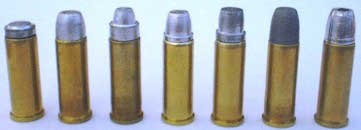
|
|
.32 S&W Long ammo, loaded with a few of the excellent
cast bullet designs available (l-r: NEI #75 wadcutter, RCBS
.32-90-Cowboy bullet, Lyman 313445, Lee custom Group Buy 98 grain
Keith-style SWC, Mountain Molds Keith-style 98 grain SWC, RCBS 98
grain SWC, and the Ideal 31133 HP). |
|
The guns
That brings us to the guns -- ah yes, the guns! As mentioned earlier,
the .32 S&W Long was originally brought out in the weak, top-break S&W Model 1
1/2. I am going to skip over the old black powder hinged-frame guns since the
focus of this article is on the optimum small game hunting loads, generally
operating in the 900-1000 fps range, and these loads are entirely unsuitable for
the old top-break guns. That brings us to the Hand Ejectors -- as this is
written, I have no first-hand experience with the Model 1896 (I hope to change
that in the near future), but I have plenty of experience with the Model 1903
(and the various changes associated with that Model). This dainty little
I-framed sixgun is just about the definitive "grouse gun" in my mind -- light,
easily carried in a vest pocket or bib overalls when hunting big game, and able
to dispatch a grouse quickly and cleanly without wasting a lot of meat (and
without making a lot of noise). The Model 1903 was available with 3 1/4", 4 1/4"
and 6" barrels. I have shot all three, and they have all shot very well for me.
The one issue that I've encountered is that the sights are rather fine, and with
bifocals sometimes it can be a challenge to quickly get a good, clean sight
picture. But these little I-frames sure do shoot! The 3 1/4" I have has a bore
that still has decent land/grooves, but is spider-webbed with pitting throughout
the length of the barrel -- and it will still put 12 shots into 1 1/4" at 50
feet! The other I-frame .32 S&W Longs I've shot have displayed similar
capabilities. I ran some tests on 4 different I-frame .32 S&W Long revolvers --
all 4 guns would allow a Hornady 85 grain XTP (that mikes .312" on the nose) to
pass smoothly (the 3 1/4" Model 1903 was a little snug, but it still passed),
and none would allow a cast bullet sized .313" to pass. Clearly, a good place to
start with cast bullets for these little guns is .312".
|
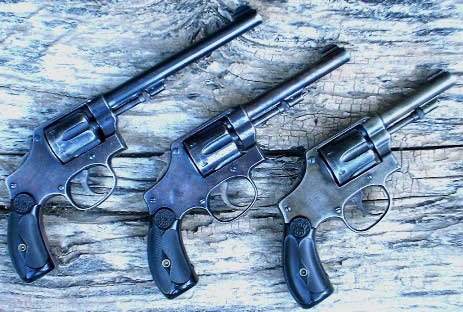
|
|
The I-frame .32 S&W Long (Model 1903) was available
with 3 1/4", 4 1/4" and 6" barrels. |
|
S&W built the I-frame (and the improved I-frame) up until 1961, when
they introduced the J-frame. By this point, the revolver was known as the Model
30 (round butt) or Model 31 (square butt). Years ago, I picked up a 3" Model 31,
and it not only shoots to the fixed sights, it groups quite nicely to boot! I
haven't carried this little J-frame very often because it's just too pretty to
get beat up when I'm in the black timber hunting elk, but it has nonetheless
accounted for a handful of vermin and small game in the off-season. Throats on
this revolver run just a little over .313", so that's what I size cast bullets
when I'm loading for it.
|
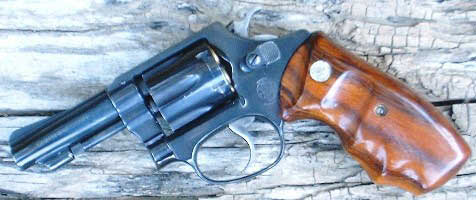
|
|
The J-frame .32 S&W Long (Model 31-1), with a 3" barrel and fixed
sights. |
|
S&W also built a few .32 S&W Longs on the K-frame. These tend to be
rather rare, and you don't run across them every day. I was fortunate to pick up
a 4" M&P in .32 S&W Long a while back, and it has quickly turned into one of my
personal favorite revolvers. The bluing on the barrel is worn, but mechanically
this gun is in very good shape, and it is one fine shooter! In this revolver,
cast bullets sized .313" are a snug fit in the throats, and so that is how I
size them.
|
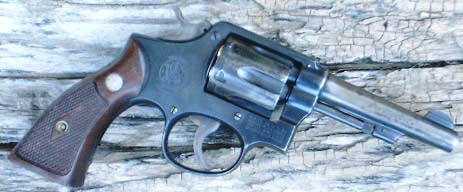
|
|
S&W made a few M&Ps (K-frame) chambered for .32 S&W Long. |
I have always wanted a K-32 Target Masterpiece, but given the steep
prices they tend to command, I just haven't been able to find one that I could
afford. So a number of years ago I decided to have a custom gun built instead
(and still ended up saving a bunch of money). I bought a 6" full-lugged Model 16
barrel (from the .32 H&R Magnum production run) and a K-22 cylinder, and had
these fit to a K-38 frame. I also commissioned a set of very tight reamers to be
made up (.0015" clearance on the chamber dimensions, and .3125" for the
throats), and took all these parts over to my good friend Dave Ewer and asked
him to build the gun. This gun is mechanically VERY tight, and it shoots
superbly! In hindsight, I probably should have gone with about .003" clearance
on the chamber dimensions, as occasionally variations in crimp dimensions can
cause problems with getting ammo to chamber, but boy does this gun shoot! When
hunting, this gun gets cast bullets sized .312", at 900-1000 fps, and it shoots
them all day long into little-bitty groups. This is truly a connoisseurs small
game handgun.
|
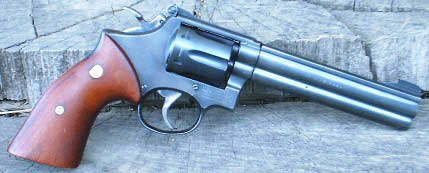 |
|
Custom K-32 target gun built by Dave Ewer. This tight
little gun is exquisitely accurate! |
|
Well that covers the I, J and K-frames. Believe it or not, I have seen
exactly one N-frame .32 S&W Long. Now before anybody gets their "tail tied in a
knot" over that statement and calls me a liar, this was most certainly NOT a
factory gun! This was a fixed sight 3 1/2" .45 caliber N-frame that somebody had
sleeved the chambers and re-chambered/re-throated them for .32 S&W Long, and
then they had lined the barrel with a .32 liner, and nickel plated the whole
mess. Why somebody went to all that work, I don't know, but it was certainly a
unique handgun. Who knows? It might have been a real tack-driver.
Applications
The .32 S&W Long makes an excellent target gun. The custom K-frame
described above was originally built as a bullseye gun, intended for wadcutters
(either home-cast or commercial hardcast, and the Oregon Trail Bullet Company
makes a fine 98 grain .313" double-ended wadcutter), loaded over 2.0 grains of
Bullseye. Years ago, I shot a number of bullseye matches with this gun for the
centerfire stage and it served extremely well. It is extremely accurate, and the
trivial level of recoil makes recovery very easy during a rapid fire string. The
full-lug barrel makes the gun slightly muzzle heavy, so the sights "hang" on the
target very nicely. All in all, a very nice bullseye package.
Anymore, I don't shoot as much bullseye as I used to, so this gun gets
used mostly for small game hunting now. It is big enough and heavy enough that
it doesn't really fit in as a "second gun" when I'm hunting big game, so this
gun gets carried main as a primary gun when hunting edible small game, a role in
which it excels. It is particularly well-suited for cottontails with the 90-100
grain cast SWCs at 900-1000 fps, and it is notably more effective at anchoring
small game than a .22 handgun, yet it doesn't spoil a lot of meat. My favorite
way of fixing rabbit is to quarter them, bread the pieces, adding a little black
pepper and garlic salt to the flour, and pan fry them. Quick, simple, easy and
tasty!
When hunting tree squirrels, I like to use the .32 S&W Long loaded with
wadcutters. Since squirrel hunting commonly involves shooting upwards into the
tree canopy, in the event of a miss a wadcutter tends to become unstable
(especially if it hits branches) and start to tumble, shedding velocity quickly
and falling to earth a short distance away. A more stable profile (e.g. SWC or
round-nose) could potentially maintain its stable nose-forward flight, fly great
distances, and return to earth at high velocity, potentially causing property
damage or personal injury. A 98 grain wadcutter at roughly 750 fps will take a
bushytail cleanly, but not fly into the next county if the shooter misses. I
lived in the southeast for a number of years and became a big fan of Brunswick
stew while there. For squirrel, I throw the skinned carcass (whole) into some
salted water and put it on a slow simmer for a couple of hours. Then I pull the
meat out and let it cool, and pull all the meat off the bones, putting the meat
back into the soup-stock with a little Worcestershire sauce, onions, carrots,
potatoes, barley, salt and pepper and simmer till the veggies are done. Don't be
late for dinner, or you won't get any!
The .32 S&W Long also makes a good varmint round. For critters like
ground squirrels and prairie dogs, I will commonly use the Keith-style SWC’s
loaded to around 1000 fps, and it pops burrowing rodents smartly. For jack
rabbits, I generally want a little more "thump" and will commonly load the .32
S&W Long with a cast HP like the Lyman/Ideal 31133 (the 109 grain HP version of
the 3118), cast soft (BHN of 9 or less, e.g. 25-to-1 alloy) and load it to 1000
fps with 3.0 grains of Red Dot (this load is too hot for the I-frame guns and
only gets shot in my K-frame .32s). This load does not produce the explosive
expansion that magnum cast HP loads commonly deliver, but it does offer notably
better killing power for moderate-sized vermin like jack rabbits, nutria,
rock-chucks, and such.
Perhaps my favorite application of the .32 S&W Long is as a grouse gun.
Here in the Pacific Northwest, grouse are commonly encountered in the mountains
during deer and elk season. These encounters are typically at close range
(commonly ~15 yards or less), and in country where big game (the primary quarry)
is likely to be nearby. This means that a small, accurate, quiet handgun,
capable of killing grouse cleanly without wasting a lot of tasty meat makes a
sensible companion. The .32 S&W Long, loaded with wadcutters at target speeds,
does a fine job putting grouse in the game bag (so do the Keith-style SWC’s, but
the target wadcutter loads are a little quieter, and thus less likely to spook
big game). My favorite way to prepare grouse is to bone out the meat and slice
it into bite sized chunks, simmer it gently in some white wine (preferably
Riesling), butter, a little dab of Dijon mustard, some garlic, onions, and
sliced mushrooms, and it becomes a meal fit for a king.
Yes, in some ways the .32 S&W Long is a relic from a by-gone era, a 19th
century pocket pistol for self-defense. More effective cartridges have since
been developed for that application, but the .32 S&W Long still has a place in a
handgunners battery. While the .32 S&W Long lead round-nose factory ammo isn't
particularly effective, when the cartridge is loaded with wadcutters at 750 fps
or SWC’s at 900-1000 fps, it makes an outstanding small game round for the
modern handgun hunter.
|
-
Glen E. Fryxell |
Top of Page |
|
|
|
|
|
Addendum on cast SWC's in
the .32 S&W Long |
|
Commonly, when I am working up new loads for the .32 S&W Long, I will do all the
shooting and chronographing with the custom Ewer K-32 bullseye gun described
above. It is very accurate so I know that I'm getting everything out of the load
that it has to offer, and if the chronograph tells me that the loads are a
little too warm for the I-framed guns, I don't have to worry about damage to the
very strong K-frame. The realization hit me that I had chronographed the
wadcutter loads out of the I-framed revolvers, but I had just taken the other
loads out and shot stuff with them, without knowing exactly how fast they shot
in the various guns. This last weekend, I decided to rectify that oversight.
|
All cast bullets cast of range scrap (BHN ~ 10) |
|
|
Sized .312" lubed with 50/50 beeswax/moly grease |
|
|
Winchester Small Pistol primers |
|
|
|
Temperature ~75F |
|
|
|
| |
|
Velocity data for .32
S&W Long loads |
| |
|
|
3.0 grains of W231 with the Lee 98 grain SWC |
|
2.5 grains of Red Dot with the Mountain Molds 102 grain SWC |
|
Ewer K-32 (6")
|
974 fps |
|
Ewer K-32 (6") |
857 fps |
|
|
3 1/4" Model 1903 |
820 fps |
|
3 1/4" Model 1903 |
727 fps |
|
|
4 1/4" Model 1903 |
908 fps |
|
4 1/4" Model 1903 |
782 fps |
|
|
6" Model 1903 |
866 fps |
|
6" Model 1903 |
734 fps |
|
| |
|
|
3.0 grains of W231 with the Mountain Molds 102 grain SWC |
|
|
Ewer K-32 (6") |
911 fps |
|
|
|
3 1/4" Model 1903 |
766 fps |
|
|
|
4 1/4" Model 1903 |
836 fps |
|
|
|
6" Model 1903 |
792 fps |
|
|
The first thing that jumps out of these numbers is that these loads are going
notably slower from the old I-framed guns than they are out of the tight custom
K-32 bullseye gun. This in and of itself isn't surprising, but the margin of
difference between the 6" K-32 and the 6" I-frame took me by surprise (~120
fps). The other thing that jumps out of these numbers is that the 4 1/4" is
consistently the fastest of the I-framed guns, and it is consistently ~40 fps
faster than the longer barreled 6" Model 1903. As my friend John
Taffin has said for years when people ask him about revolver velocities, "Each
sixgun is a law unto itself.". John's right.
All of these guns have cylinder throats that run less than .313", so these
observations got me to thinking about the cylinder gaps in these various
revolvers, so I broke out the feeler gauges and made a few measurements.
|
Ewer K-32 bullseye gun |
.0025" |
|
3
1/4" Model 1903 (5th change, 1914) |
.004" |
|
4
1/4" Model 1903 (2nd change, 1906) |
.0025" |
|
6" Model 1903 (5th change, 1910) |
.005" |
Sure enough, the slow 6" Model 1903 has the largest gap, and the fast 4 1/4"
Model 1903 has the smallest gap.
Next, if we compare the two bullets by examining the data from the two loads
using 3.0 grains of Winchester 231, we see that the Lee custom Keith-style SWC
is consistently ~60 fps faster than the Mountain Molds Keith-style SWC. The
Mountain Molds SWC stays true to the design parameters laid out by Elmer Keith
(3 driving bands of equal width, large flat-bottomed grease groove, beveled
crimp groove, large meplat), and was designed with a 73% meplat. This is a
design that has proven itself for over 3/4 of a century. The Keith-style SWC
that we got as a part of the custom group buy from Lee has a meplat of .205",
which equates to about 66% (very similar to what Elmer used when he designed his
first SWC, the 429421, which leaned heavily on the 429336, the so-called "Heath
bullet" designed back before World War I; Elmer would use larger meplats on his
later SWC designs, varying between 70% and 75% of bullet diameter). There are
two possible explanations for this velocity difference between the Mountain
Molds SWC and the Lee SWC -- 1) the weight difference, and 2) the difference in
thickness of the base bands. These bullets were cast with range scrap with a BHN
of about 10 (similar to WW alloy) and the Lee SWC weighs 98 grains, and the MM
SWC weighs 102 grains. Is a 4 grain difference in weight enough to cause a 60
fps difference in velocity? Maybe, maybe not. Changes in base band thickness are
known to have an impact on how well the bullet's base can seal the propellant
gases. The MM SWC has a base band that is .075" thick, whereas the Lee SWC has a
base band that is .110" thick. Which parameter is responsible for the velocity
difference? I don't know, but I suspect that it could be the base band
difference. In any event, I think it would be appropriate to use this example to
modify Taffin's Axiom to, "Every bullet is a law unto itself.". As for the 60
fps difference, I'm not going to get too wound up over it since both of these
loads use good flat-pointed bullets and there isn't a grouse in the world that
could ever tell the difference between these two loads.
Lastly, if we compare the two loads using the Mountain Molds SWC (over 3.0
grains of 231 and 2.5 grains of Red Dot), we see that the 231 load tends to be
about 50 fps faster. In my experience, the Red Dot load is more consistently
accurate (from gun to gun). Some guns shoot the 231 load well, others don't, but
they all seem to like the Red Dot load, so that's a load that I generally tend
to gravitate towards.
The bottom line is that these loads were going a little slower than I thought
out of the old I-frame guns, but these flat-pointed bullets still kill rabbits,
grouse and squirrels just fine, thank you.
|
|